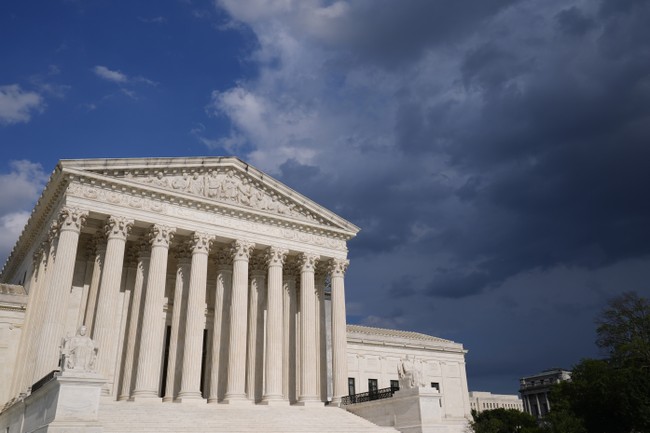Yesterday, I wrote a post about the oral arguments taking place at the Supreme Court today. This is a case involving section 2 of the Voting Rights Act of 1965. The state of Louisiana created new congressional districts in 2022. A group of 12 black plaintiffs (and the ACLU) sued Louisiana because only one of the six new districts were majority minority.
Louisiana is about 31% black so the case argued that under the VRA, at least two of the six districts in the state needed to be majority minority districts to allow those black voters to elect a representative of their choice. That resulted in a new map that looks like this.
Today, the Supreme Court will hear oral arguments in Louisiana v. Callais, which will decide if mandating that states draw congressional districts based on race under the Voting Rights Act is constitutional.
For years, Democrats have taken red states to court to mandate that… pic.twitter.com/bzKwCAA4Na
— Greg Price (@greg_price11) October 15, 2025
The case actually came up for oral arguments last year but the Justices never issued a decision in the case. Instead, they scheduled new arguments for today which court observers all agree means they are thinking about making major changes to the law.
There’s a clear partisan angle to all of this. Black voters tend to vote for Democrats in overwhelming numbers. The result is that section 2 of the VRA effectively ensures Democrats have safe districts in a bunch of otherwise red states in the south.
Just last week, Politico noted that left-leaning voting rights groups were panicking over today’s oral arguments because if section 2 gets tossed out, a bunch of save blue districts would likely disappear. How many? Possibly as many as nineteen.
Ahead of the court’s Oct. 15 rehearing of Louisiana v. Callais — a case that has major implications for the VRA — two voting rights groups are sounding the alarm, warning that eliminating Section 2, a provision that prohibits racial gerrymandering when it dilutes minority voting power, would let Republicans redraw up to 19 House seats to favor the party and crush minority representation in Congress.
That calculation, made in a new report from Fair Fight Action and Black Voters Matter Fund shared exclusively with POLITICO, would all but guarantee Republican control of Congress…
Without Section 2, up to 30 percent of the Congressional Black Caucus and 11 percent of the Congressional Hispanic Caucus could be drawn out of their seats, according to the report.
So that’s what’s at stake today. Mark Meuser, a lawyer for the Dhillon Law Group, put it this way in a post on X:
Today the Court hears oral arguments in Callais v. Louisiana, a case that could reshape redistricting for decades.
Here’s what’s at stake: for years, federal courts have interpreted the Voting Rights Act (VRA) to require states to gerrymander congressional districts so minority groups are virtually guaranteed the ability to elect a representative of their same race. Callais challenges that approach, arguing that the current interpretation of the VRA violates the Equal Protection Clause of the U.S. Constitution because it forces states to make race the predominant factor in drawing district lines.
Democratic-aligned advocacy groups have weaponized this reading of the VRA to carve out safe Democratic seats. Instead of drawing compact districts that follow cities, counties, and communities of interest, states are pressured to create bizarre, snake-like districts designed to hit racial targets. The result is a distorted Congress. In 2024, Donald Trump won the presidential election decisively, yet Republicans hold only a razor-thin margin in the House. That mismatch is not by chance.
When districts are drawn to guarantee that one party always wins, it shifts power away from the people and toward special interests. It lets political insiders and activist groups pick the politicians who govern us, rather than letting voters choose their representatives.
If the Court agrees with Callais, the decision could dramatically limit the use of race in redistricting nationwide. That means the gerrymandered maps Gavin Newsom is pushing with Prop 50 could be ruled unconstitutional.
This is one of the most important redistricting cases in decades. The outcome could restore fairness, compactness, and accountability to how congressional districts are drawn.
So how are the arguments going so far? I haven’t listened to the entire argument but someone who did said there was a pretty clear split with three liberal justices trying to preserve section 2 and 3 conservatives who clearly want it gone.
Sotomayor keeps going, and now Kagan is on again, so a quick summary here:
Thomas, Alito and Gorsuch are siding to gut Sec 2 of the VRA
Kagan, Sotomayor and KBJ are favoring keeping it.
The liberals have talked A LOT, trying to demonstrate that race is still needed to…
— CA ET Nerd (@earlyvotedata) October 15, 2025
Kavanaugh appears to be a 4th vote for just getting rid of section 2.
Kavanaugh is allowing Aguinaga to counter the liberals arguments that harm is being done by the state of Louisiana.
Aguinaga says: the political process is the political process. Essentially if Louisiana wants to Gerrymander then they risk losing seats, but that’s on them and…
— CA ET Nerd (@earlyvotedata) October 15, 2025
However, CNN reports that Kavanaugh may be angling for a compromise.
Kavanaugh, a conservative, has repeatedly signaled an interest in the Trump administration’s approach to the case. The Trump administration sided with Louisiana – and against the Black voters in the case – but in a way that is slightly less far reaching than the state’s argument when it comes to the Voting Rights Act.
The Trump administration has suggested that race might still be used in a limited way to redraw district boundaries in some circumstances. Louisiana has argued, by comparison, that race cannot be used at all.
Justice Barrett was a bit harder to read but Justice Jackson is going all out to argue for preserving the law.
KBJ is now really hammering race and the fact that it is about “unequal opportunity for black voters” and she believes it is still going on.
She’s really attacking Aguinaga right now, she’s getting very animated.
She wants the state to say that they have a compelling interest…
— CA ET Nerd (@earlyvotedata) October 15, 2025
Some audio from the arguments today. Here’s Justice Thomas asking why the new majority minority district was drawn. The solicitor general for Louisiana says it only exists because a court threatened to do it itself.
🚨 BREAKING: SCOTUS Justice Clarence Thomas takes a BLOW TORCH to Voting Rights Act districts that favor Democrats on the basis of race
Thomas successfully makes the point that the “black” district WOULD NOT EXIST in Louisiana without being forced to by the courts to consider… pic.twitter.com/zag6h3gk4Z
— Eric Daugherty (@EricLDaugh) October 15, 2025
This clip of Justice Jackson is also getting some traction. She seems pretty worked up and says at one point to Louisiana’s solicitor, “just trust me on this.”
🚨 JUST IN: DEI Supreme Court Justice Ketanji Jackson is LOSING IT because she knows the race-based VRA Congressional districts are about to be abolished pic.twitter.com/y9ooR0OBcp
She is YELLING at the counsel and is clueless as to how the VRA processed even worked in Louisiana.…
— Eric Daugherty (@EricLDaugh) October 15, 2025
Here’s a lawyer for the NAACP arguing that section 2 is necessary because “white Democrats” were not voting for black Democrats.
NAACP lawyer argues at SCOTUS that it’s necessary to create race-based congressional districts because “white Democrats were not voting for black candidates whether they were Democrats or not.” pic.twitter.com/PlTPSYNqye
— Greg Price (@greg_price11) October 15, 2025
Outside the court there was a protest of about 100 people who want racial gerrymandering to continue indefinitely.
Protesters gathered outside the U.S. Supreme Court this morning as oral arguments in Louisiana v. Callais get underway before the justices, who hold a conservative majority. The case has potential to fundamentally change the Voting Rights Act. pic.twitter.com/WZG169zM7u
— Ashley Murray | @ashleymurray.bsky.social (@Ashley__Murray) October 15, 2025
So where is this all going to land? I don’t think it’s as clear as some previous arguments. There seem to be 3 liberals for preserving section 2, three conservatives for eliminating it and perhaps 3 conservatives (Kavanaugh, Barrett and Roberts) who may (or may not) be looking to weaken but not end it. So I think the likely outcome here is a 6-3 decision with an outraged dissent from Justice Jackson, but I’m not sure how far that decision will go.
Update: The NY Times says the justices appeared “poised to upend” section 2. The question is could it impact the 2026 midterms? The answer is maybe. It depends when the court issues a decision.
If Section 2 of the law were to be found unconstitutional, states across the country would be free — though not required — to redraw their congressional and state legislative lines without regard to protecting the voting power of minority communities.
But the court often does not issue major opinions until late in its term, often in June or early July. That would be well past many states’ filing deadlines and primary elections for the November 2026 election, and make the introduction of new maps for the midterms all but impossible.
The court could move more quickly, however, and issue a ruling in December or January, a rare though not impossible outcome given that the justices have heard the case once before and chose to rehear it early in their new term, which began last week. Were that to happen, state legislatures could work quickly to redraw their maps in time for primary elections next year.
Fingers crossed. It would be great to the GOP pick up new seats next year.
Editor’s Note: The Schumer Shutdown is here. Rather than put the American people first, Chuck Schumer and the radical Democrats forced a government shutdown for healthcare for illegals. They own this.
Help us continue to report the truth about the Schumer Shutdown. Use promo code POTUS47 to get 74% off your VIP membership.
Read the full article here











![Another Afghan National Biden Let In Arrested Over ‘Terror Plot’ in Texas [WATCH] Another Afghan National Biden Let In Arrested Over ‘Terror Plot’ in Texas [WATCH]](https://www.lifezette.com/wp-content/uploads/2025/08/2025.08.19-09.10-lifezette-68a4e83ad6bf1.jpg)
